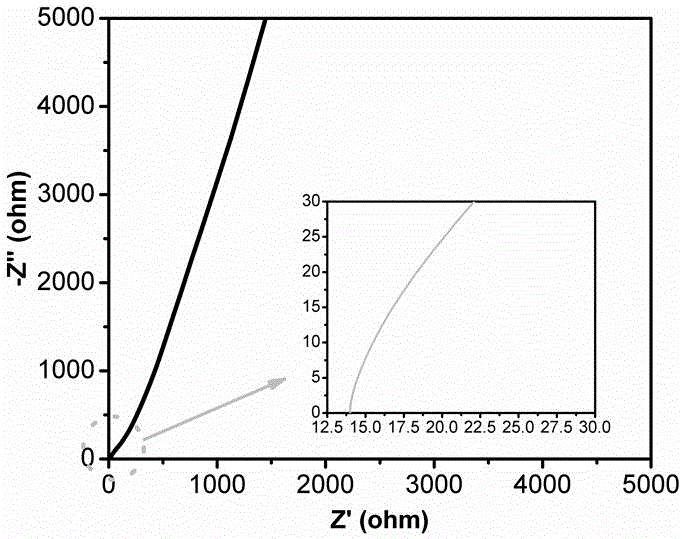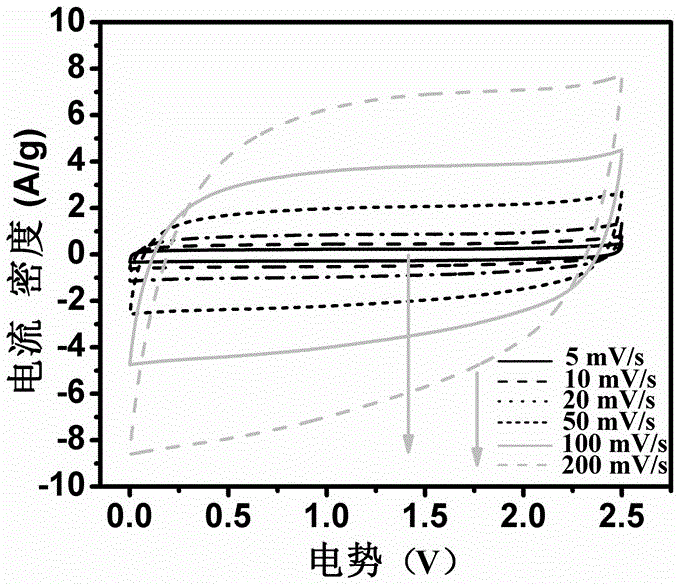Boron-containing gel polymer electrolyte and preparation method and application thereof
A technology of gel polymers and electrolytes, applied in the direction of electrolyte immobilization/gelation, circuits, electrical components, etc., can solve the problems of easy leakage, high temperature, flammability and explosion, etc., and achieve good low temperature performance and high mechanical properties , high dissociation effect
- Summary
- Abstract
- Description
- Claims
- Application Information
AI Technical Summary
Problems solved by technology
Method used
Image
Examples
Embodiment 1
[0033] Add 50 mmol phenylboronic acid (PBA), 50 mmol 2,3-dihydroxypropyl methacrylate (GMMA), 50 g 4Å molecular sieves and 300 ml anhydrous dichloromethane into a 500 ml three-necked beaker, and pass inert gas for Protection, and the solution was stirred continuously for more than 24h. The mixture was suction-filtered more than 3 times, and then washed with a neutral alumina column to obtain a pure dichloromethane solution of olefinic boron-containing heterocyclic monomer (GMMA-PBA). After rotary evaporation, the pure light yellow monomer (GMMA-PBA) was obtained, and the yield was about 1.
[0034] Take 2ml of the above-mentioned monomer GMMA-PBA, the content of photoinitiator (benzoin dimethyl ether) is 1%-5%, glycidyl methacrylate (GMA, the content is 10% of GMMA-PBA) and 1ml of 2M DMF LiClO 4 Add it into a 5 ml beaker and stir evenly, then cast it in a 0.5mm thick PTFE mold; under the protection of an inert gas, the LED lamp irradiates the mold for about 6 minutes to obta...
Embodiment 2
[0036] Add 50 mmol of phenylboronic acid (PBA), 50 mmol of 2,3-dihydroxypropyl methacrylate (GMMA), and 100 ml of anhydrous toluene into a 200 ml three-neck beaker equipped with a condenser tube and an azeotropic device. Azeotropic water removal at 130-145°C for 6-8 hours. The mixture was suction-filtered more than 3 times, and then washed with a neutral alumina column to obtain a pure toluene solution of olefinic boron-containing heterocyclic monomer (GMMA-PBA). After rotary evaporation, the pure light yellow monomer (GMMA-PBA) was obtained, and the yield was about 1.
[0037]Take 2ml of the above-mentioned monomer GMMA-PBA, the content of photoinitiator (benzoin dimethyl ether) is 1%-5%, glycidyl methacrylate (GMA, the content is 10% of GMMA-PBA) and 1ml of 2M DMF LiClO 4 Add it into a 5 ml beaker and stir evenly, then cast it in a 0.5mm thick PTFE mold; under the protection of an inert gas, the LED lamp irradiates the mold for about 6 minutes to obtain the copolymer P((GM...
Embodiment 3
[0039] Accurately weigh 2ml of GMMA-PBA, a boron-containing heterocycloalkene monomer, the content of photoinitiator (benzoin dimethyl ether) is 1%-5%, the content of glycidyl methacrylate (GMA, 20% of GMMA-PBA ) and 1ml of 2M DMF·LiClO 4 Add it into a 5 ml beaker and stir evenly, then cast it in a 0.5mm thick PTFE mold; under the protection of an inert gas, the LED lamp irradiates the mold for about 6 minutes to obtain the copolymer P((GMMA-PBA)-GMA). The thickness of the film is 150-200 μm. The conductivity of the polymer electrolyte was measured using a sandwich structure that was assembled in a 2016 button cell in the order of stainless steel / polymer electrolyte membrane / stainless steel. The AC impedance spectrum of the polymer electrolyte membrane was tested, and the room temperature conductivity was calculated to be 1.5×10 -3 S cm -1 .
PUM
 Login to View More
Login to View More Abstract
Description
Claims
Application Information
 Login to View More
Login to View More - R&D Engineer
- R&D Manager
- IP Professional
- Industry Leading Data Capabilities
- Powerful AI technology
- Patent DNA Extraction
Browse by: Latest US Patents, China's latest patents, Technical Efficacy Thesaurus, Application Domain, Technology Topic, Popular Technical Reports.
© 2024 PatSnap. All rights reserved.Legal|Privacy policy|Modern Slavery Act Transparency Statement|Sitemap|About US| Contact US: help@patsnap.com









